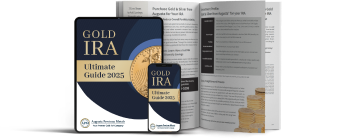How to Convert Your IRA to Gold or Silver
This article provides a guide on converting a traditional Individual Retirement Account (IRA) to a gold or silver IRA and breaks down all the steps involved in the process.

Written by Rick Erhart
Rick Erhart is an experienced precious metals professional with more than ten years in the field. He earned a degree in finance and is widely regarded as a specialist in self-directed IRAs.
Saving for retirement can be tricky, as you need enough funds to enjoy a comfortable life while recognizing that financial markets may shift dramatically in 20, 30, or even 40 years.
Investing in precious metals offers a way to bring balance, preserve wealth, and diversify a portfolio that might otherwise rely heavily on assets like stocks or bonds, which often experience greater ups and downs due to changing market conditions.
Here are some practical steps to follow if you’re considering transferring your individual retirement account (IRA) into a gold or silver IRA to leverage the benefits of precious metals.
Key Points
- If you’re looking to convert your IRA to a gold IRA, you’ll need to open a self-directed IRA with help of a gold IRA company and move funds from an existing IRA to a new account that permits investments in precious metals. The gold IRA company will then acquire gold on your behalf, which will be securely held in a storage facility approved by the IRS.
- Moving funds directly from a 401(k) to a gold IRA can help you avoid taxes or penalties. However, be sure to confirm that all investments meet IRS rules for precious metals and be mindful of fees for account setup, maintenance, and storage.
Download a free gold IRA guide to learn everything you need to know about moving your IRA to a gold IRA, including fees, tax considerations, benefits, potential pitfalls, and more.

How Does a Gold or Silver IRA Work?
A gold or silver IRA is a type of self-directed individual retirement account that allows you to include physical precious metals (such as gold and silver) in your retirement portfolio. These accounts provide exposure to physical precious metals and add stability to your long-term financial strategy.
Regular IRAs that focus on stocks, bonds, and mutual funds don’t permit investments in physical precious metals, because the IRS considers them collectibles. Investing in such assets through a regular IRA could trigger an immediate taxable distribution, potentially leading to taxes and a 10% penalty.
To avoid this, you need a specifically designed retirement account that permits precious metals investments, called a self-directed IRA, which offers gold IRA benefits like diversification and protection against inflation.
Setting up a gold or silver IRA often involves higher fees than a standard IRA. This is because the physical metals must be stored in a secure, IRS-approved depository. Choosing a reputable custodian who understands the rules for precious metals IRAs is instrumental for compliance and your personal peace of mind.
The contribution limits for gold and silver IRAs match those of traditional IRAs. For 2025, you can contribute up to $7,000 annually, or $8,000 if you’re age 50 or older. You’re free to open multiple IRAs, but the total contribution limit applies across all your IRAs combined, not per account. For example, you can’t contribute $7,000 to each IRA; your total contributions across all accounts must stay within the annual limit.
3 Steps to Convert an IRA to a Gold or Silver IRA
If you have an existing IRA and want to move your savings into a gold or silver IRA, follow these three straightforward steps.
Choose a Gold IRA Company and Set Up a Self-Directed IRA
Begin by selecting a gold investment company that specializes in precious metals IRAs. To invest in gold or silver as part of your retirement, you’ll need a self-directed IRA managed by a qualified custodian.
If you haven’t selected the company yet, be sure to read our guide on the best gold IRA companies to help you make an informed decision based on their reputation, fees, and customer reviews.
A gold IRA company will help you set up a new retirement account with a trusted custodian that is experienced in handling precious metals IRAs. Many IRA custodians don’t allow investments in alternative assets like precious metals, because they require specific storage and management due to their physical nature. A self-directed IRA that contains gold or silver must comply with IRS rules on metal purity and secure storage.
Handling a gold and silver IRAs comes with certain storage fees, as it often costs more than maintaining a traditional IRA. Keep in mind that home storage is not allowed as per IRS rules. For this reason, the precious metals must be kept in an IRS-approved storage facility.
Once you’ve selected a reputable gold IRA company, open a self-directed IRA with them to begin the process. A reputable gold IRA company will be there every step of the way to streamline the process.
Transfer Funds into Your New Account or Fund it
After opening your self-directed IRA, the next step is to transfer funds from your current IRA into the new account. The process is generally simple, but it depends on the type of account you hold. A traditional IRA can be converted to a Roth IRA, while a Roth IRA can only be rolled over to another Roth IRA.
There are two ways to fund your new account: a direct rollover or an indirect rollover. With an indirect rollover, you must cash out your IRA and reinvest the funds within 60 days to avoid penalties. A direct rollover is often the preferred option, as it involves a direct transfer from one account to another. If you choose an indirect rollover, you have to plan carefully to meet the deadline.
Purchase Precious Metals and Arrange Secure Storage
Once your account is funded, select the precious metals that best suit your investment goals and make your purchase. It can be gold or silver bars, coins, or a mix of everything. Eligible metals for an IRA include gold, silver, platinum, and palladium, provided they meet IRS purity standards.
Physical precious metals must be kept in an IRS-approved depository. Many custodians offer storage solutions or partner with trusted facilities to handle this for you. A gold IRA company will help you find it, so choosing a company that manages both the purchase and storage of your metals can simplify the process and save you time.
Conclusion
To move funds from an existing IRA into a gold or silver IRA, you should start by selecting a trusted custodian who specializes in self-directed IRAs. Next, open an account, complete the rollover process, and purchase IRS-approved gold or silver.
If you prefer an alternative to an IRA rollover, you can diversify your retirement portfolio by investing in gold-related exchange-traded funds (ETFs), mutual funds, or stocks that focus on precious metals.
